 |
| Oversized Airport Kunming |
After 24 hours in Kunming walking in the rain to places that had closed down, as the bird and flower market which had a pretty jolly description on the itinerary, but on site, no flowers and only two stands of parakeets, rabbits, kittens, pigs and mice, then a trip to a suspect “leather carving class”, only to discover it was some guy who was copying cowboy belts and purses one gets in America, we felt gloomy, even though the Green Lake Hotel was a true Chinese hotel, the usual “large” but offered high tea in three different areas and, get this, I was able to watch the current The Voice on TV in English.
 |
| Cages of animals for sale |
Another early morning departure, still raining, foggy, cooler, and another mile walk through a “new” airport bigger than most airports in the US, and finally we rose above the clouds and saw sunshine. There is hope, I thought.
 |
| Songzanlin Monastery in Shang-ri-la |
When we arrived in Zhongdian, there was Karma in the air. It was clean. Altitude was high. The airport was small and to the point, with all the warmth of Khampa Tibetan culture.The Chinese call this city Shang-ri-la, just like the movie. We are close to the Tibetan border here in Yunnan province, and the architecture is all that makes Tibet so appealing. Here they can use wood and brick to build the quaint colorful structures because of the abundance of wood that doesn’t exist across the border. And gleaming over all the city (no skyscrapers, at last) is the Songzanlin Buddhist Monastery with its gold trim and black curtains of yak hair with symbols on them. Somehow I felt at ease with familiarity. But also out of breath. We were at 9000 feet high in a snap. The lungs need time to catch up, especially after the days of breathing deep pollution.
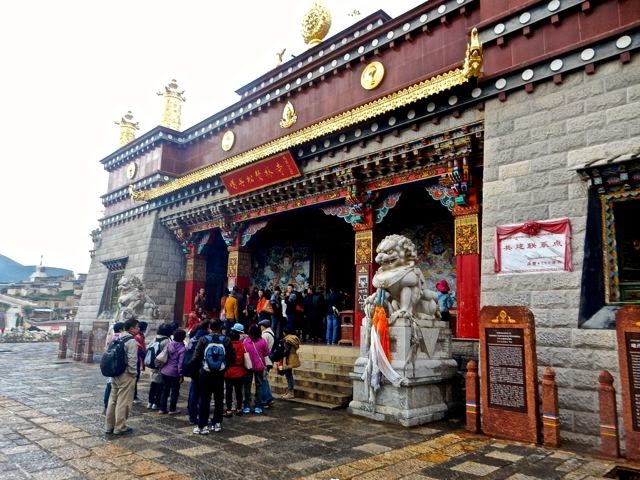 |
| Waiting to arrive at gate |
Our very first stop was at the Monastery. Busloads of Chinese were unloading tourists. This seat of Tibetan Buddhism was first built in the 17th century under the hands of the fifth Dalai Lama. Our current Dalai Lama is number 14. The name Dalai Lama means “Great Sea of Learning or Wisdom” and was a political title set up by the Mongols to keep control of Tibet. Now it has more religious connotations and mysticism, and means the highest incarnation of the Gelugpa Sect which now dominates Tibetan Buddhism. Like so many cultural institutions, during the Cultural Revolution of Mao ZeDong, the place was razed to the ground, and 4000 monks fled or were killed, totally devastated, so unfair to history, which Mao tried to wipe out so as to not to interfere with his dreams.In 20 years, construction and power of 800 monks, many originals who suffered the persecution under Mao and fled to India, have returned to rebuilt this powerful palace of worship, study and meditation.
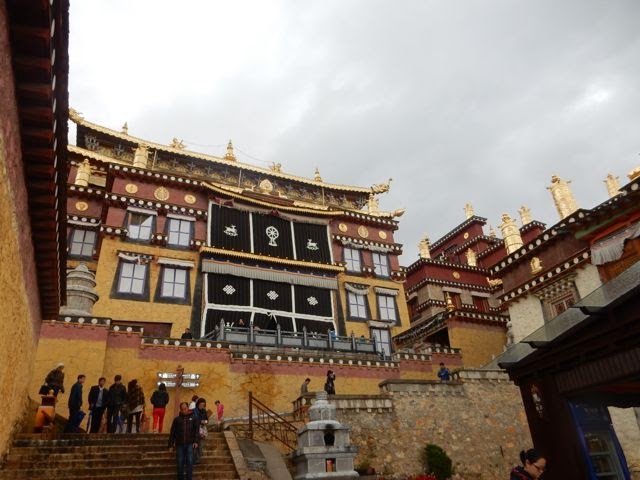 |
| Yak haor curtains and steps to climb |
As we walked under the Arch, in the distance I could hear the chanting prayers of some of the 400 monks stationed here today. But the challenge was to climb about 150 stairs, which I rose to with enthusiasm until I got to about step 10. Whew. Had to stop and rest. And I did this about every ten steps until, praise the Lord, I made it to the top. In store was another amazing experience, thanks to the persistence of our guide (also a Tibetan). We had been promised an audience with the “Little Buddha”, It was a no, that’s impossible, well, let me see, I’ll call my friend, to our guide beckoning us up a few more stairs and a right turn into sort of a backyard area to a small room. I had no inkling of what a “Little Buddha” meant, but I figured it was major. And when we removed our shoes and entered a tiny room, sitting on a bed with the rust red and gold blankets and robes wrapped around him, was this precious child.
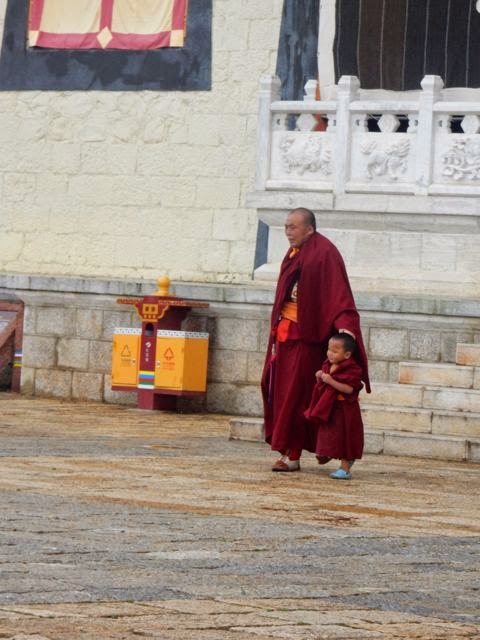 |
| Monkship starts at 3 |
Somehow I was shocked to see a child, who is the same age as my grandson Henry, 7. Standing beside him was his very handsome teacher, who has the responsibility of not only familiarizing him with Chinese and Tibetan languages (these come first with writing), but also the wisdom, history and powers of Buddha. In the room were the usual paintings and wall hangings of Buddha and in corners, boxes of toy cars and trucks. Immediately we offered the white Katas (holy scarves) to him with two hands, getting on our knees (ouch) and bowing properly like one would for royalty, and he put the scarf on my neck and patted my head and I groaningly stood up and moved to a floor pillow on the side. The Little Buddha went from serious to smile to sometimes boredom to wrapping and rewrapping the robes. He was playing with an eraser. And his teacher had him in his eye the whole time. Yes, the Little Buddha does get time to see his Mom and to play on trips home. But his task is a serious one.
 |
| Little Buddha of Shang-ri-la |
I asked if he knew what Legos were (since that is a big part of my grandsons passion) and the teacher said no. So I am bound to send him some Legos for building and entertainment. The teacher gave each of us a can of milk with a cartoon character on it, a gift from the holy child. I asked if we could take a photo, and it was allowed, but then Jim and the child had a joyful time playing with the camera. (This made us remember, afterwards, how the current Dalai Lama and a famous newsman, Lowell Thomas, had built a relationship around a camera gift.)
 |
| Hanging with Good Karma |
Eventually the living Buddha will be a source of blessings and mercy for the monks of this temple but also for all followers. It is a huge responsibility and this child was chosen right from a few blocks away in the village when he was age 4 as the reincarnation of the deceased Rimpoche, who is considered a living form of Buddha who left the earth centuries ago, but has reincarnations to continue to do good and show mercy on earth. I guess it is like being a teacher, a guru or a prophet. When I was at Mt Kailash a year and a half ago, it was the time of the year when Buddhist celebrated this ascension.
 |
| Teacher and Little Buddha |
So as not to confuse, the Buddha reincarnations are not the same as the 3 Lamas who are the political and religious/spiritual leaders of the faith: The Dalai Lama (Tibet), the Karmapa Lama (in India) and the Panchen Lama, also Tibet. Since the Dalai Lama fled Tibet and cannot return there, he resides in Dharmsala, India, right on the border with Tibet. He has recently relinquished his political powers and is concentrating only on the spiritual ones, and even considering resigning and naming his own replacement (re-incarnation) so there won’t be a free for all when he dies.
 |
| Momo at Tara’s Traders Stop |
As we exited our charming meeting with the Little Buddha (who has no given name), we went to the main temple (there are 5) where beautiful chanting was flowing. Just as we were about to peek in, it ended and a swarm of monks came from behind the curtains as if they were ready for a game of soccer. One monk, tall, thin, shaved headed, handsome, looked just like Kobe Bryant. I told him so, he laughed – Bryant is a super-hero in China.
 |
| Uttara and guest |
He led us around what to me was the most extraordinarily ornate and moving temple I’ve ever been in. There was not a space anywhere not decorated with fabric or Tanghka or statues and tons of lighted yak butter candles. I wanted to light a candle for my mom and so I accepted the one the monk suggested (large candle holder), and we went to the altar and lit it. And later I found some antique wooden prayer beads which “Kobe” blessed. Meanwhile a few of the monks were blowing the long thin horns which are set up permanently on the balcony of the temple. It was such a joyful group all in dark rust red robes and running shoes for the most part.
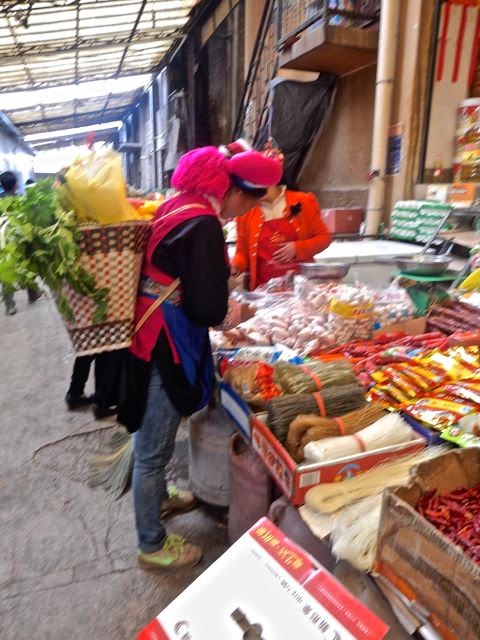 |
| Shopping at Farmers Market |
Time for our descent. The moments had been powerful. Now reality returned dealing with the altitude. Down is better. and we headed a few blocks to the town proper to an ancient trading house on the tea and horse trail for 250 years, the owner being a lady named Uttara Crees, from India, who knew Jim and had come here in 1980s when foreigners weren’t allowed, loved the place, and returned when doors opened. It is a restaurant, complete with the ghosts boards one climbs over to enter any threshold. She has a collection of Tanghkas and a wonderful porch where neighborhood ladies wearing elaborate hats stop to rest from time to time.
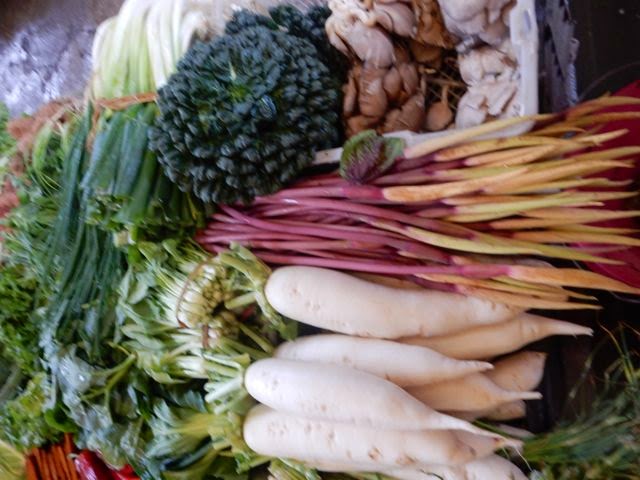 |
| Veggies at Farmers Market |
Lunch here, all made on the spot, was probably the best meal I’ve had on this trip, homemade momos (dumplings), eggplant dip for homemade flat bread, hummus, curry, wok-fried cabbage and potatoes in tumeric, the favorite spice. In January of this year, there was a major fire (mid-winter, snow, no water) that burned 300 homes, including Tara’s hotel. The town revives day by day and hopes for better tourism again. It’s worth the trip.
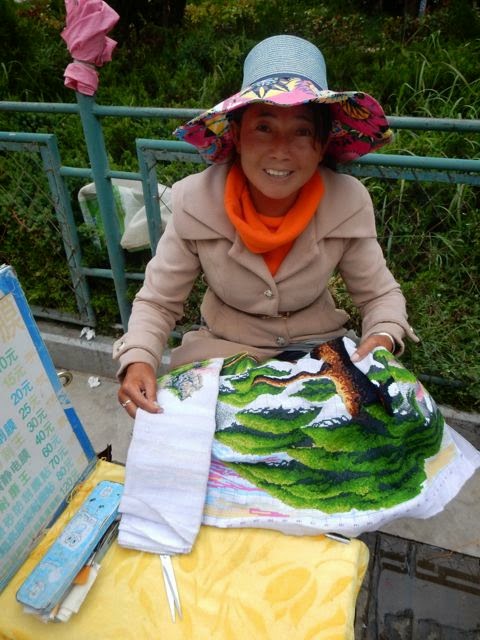 |
| Cross-stitch on the streets |
To round out today, we visited a Tanghka art school, everything must adhere to Buddhist principles and styles that have gone before, much like Catholic Icons. Then strolled through the enormous all day farmers market, discovering unusual vegetables and a major offering of slabs of bacon, giant slabs, people eat it raw to keep energy up in the cold. Dinner at the hotel was the traditional Tibet Hotpot dinner in a metal pot where broth is boiling, cooking various veggies, tofu, beef and noodles, sort of like a fondue situation in Shang-ri-la.
 |
| View from the hotel |















